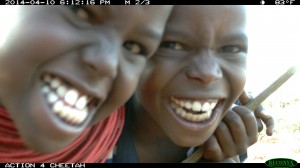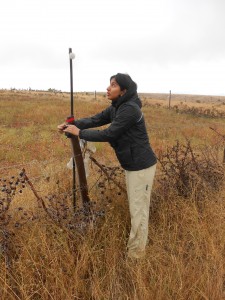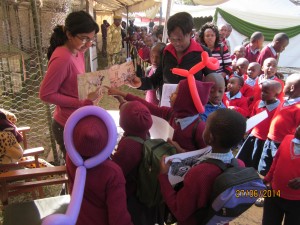
From sharing an office space with a red spitting cobra, to finding myself face-to-face with a big horn goat, all that I expected of Africa has come true.
My passion for big cats and my hope to someday start a conservation organization back in my home country of India led me to spend my summer here. While the decision to apply for an internship in Africa was an easy one, the actual process and implementation of my work here has been quite the challenge. I am currently in Salama, Kenya, interning with Action for Cheetahs in Kenya (ACK), an organization founded by Yale School of Forestry and Environmental Studies (F&ES) alumna Mary Wykstra in 2003. ACK works to “promote the conservation of cheetahs through research, awareness and community participation in Kenya.” In the first few weeks of my arrival in Kenya, I focused on understanding the various threats to cheetahs at our field site, and learning about the projects that ACK has been conducting to mitigate these issues.
Settlements and farming create major challenges for predators like cheetahs, lions and leopards, since they fragment land and habitat. An estimated 75 percent of Samala’s cheetahs move out of protected areas and into local communities, leading to human-wildlife conflict. This tension has contributed to the cheetah’s decline in this region. From a population of 30 cheetahs 10 years ago, at present, Salama may have only 3 cheetahs left. Livestock predation fosters negative attitudes towards predators and more tolerance towards poaching within affected communities. Since farming, livestock and cattle breeding provide the primary income for people in and around ACK’s field site, it is crucial for conservation work to positively impact livelihoods, while also protecting wildlife. When livelihoods are maintained, community members become more open to understanding the value of predators and biodiversity in the ecosystem. Unfortunately, when conservation efforts support livelihoods, more land gets converted to farmlands and pastures for livestock grazing, increasing habitat fragmentation and degradation. Thus, the spotted dilemma!

To address this problem of human-wildlife conflict, we set up camera traps on fences to photograph and document the animals that visit the boma (an enclosure for cattle and livestock) in the site’s fields and communities. Every week, we change memory cards and batteries in the cameras and review each boma’s pictures. Among these photos, we sometimes see “selfies” of local children who are fascinated by the cameras, but, more importantly, during the nighttime, these pictures reveal the sources of livestock predation in these communities. What we are finding is that cheetahs and leopards are not the primary cause of livestock predation; it is carnivores like hyenas and jackals that are usually the culprits. Unfortunately, cheetahs and leopards tend to bear the brunt of community frustration, and ACK is working tirelessly to try and reduce this problem. In rare circumstances, when a leopard or a cheetah has been caught on camera, we search for animal tracks, scat, and/or livestock carcasses for further conflict investigation.

After collecting and analyzing conflict data, ACK is able to recommend specific solutions to people that are directly involved in a wildlife conflict. One tactic involves setting up Nite Guard Lights as predator deterrent systems, to stop predators and ungulates from breaking through fences. While these systems are still being tested, preliminary reports and interviews show a 60-70 percent success rate. Installing these lights is not without its own challenges: we dig a trench and bury the wire, so that goats do not chew through it, and then secure the lights to the fence to prevent theft. Small measures like these go a long way in maintaining these deterrent systems. We also inform farmers of additional deterrent strategies, such as the importance of using scarecrows and noise-makers to prevent baboons from raiding crops before the harvest season. In order to help people realize the importance of wildlife, ACK also conducts natural resource management workshops using the Conservation Measurement Partnership (CMP) with the support of Miradi software. At Yale F&ES, Amy Vedder recently taught the foundation of this model; her instruction helped me participate in the meetings. This framework can be adopted in almost any conservation project, and is effective in driving community participation in natural resource planning.
For the long-term conservation of cheetahs, protecting community livelihoods is a key priority. To prevent land from being further degraded and fragmented, the way forward is to raise awareness about the role of the cheetahs in the Salama ecosystem and to involve the government in the community natural resource management workshops. By implementing these adaptive management strategies, ACK is currently balancing the issues of the dilemma (land degradation versus community livelihoods), and with a little bit of luck, it won’t be long before more cheetahs return to this region.

My summer internship has helped me better understand the challenges that people face on a regular basis, and the impact that this has on the region’s wildlife. Learning about conservation in Kenya from the ACK team has broadened my knowledge about actions to take when it comes to saving endangered species. The most important step is to gain support from people – whether it be the community, the government, other conservation organizations or your own staff.
I am so thankful to have been given this opportunity to work in Kenya because the breathtaking landscape, rich tribal culture, and ACK’s relentless efforts to promote conservation have together inspired and instilled in me an even stronger commitment to protect wild places and wild animals.
Edited by Amy Weinfurter.